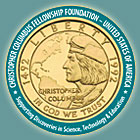
National Gallery for America's Young Inventors
2006 Inductees
Stanley Chiang, Age 18 � Fabrication of Novel Superconducting Josephson Junctions to Couple Multiple Flux States of a Quantum Bit
In 2004 Stanley combined two interests � applied physics and super conductivity � in a study of the quantum bit (qubit), the unit of memory in a theoretical �quantum computer.�
A quantum computer should be exponentially faster and more powerful than today�s computers. Currently, individual qubits have been fabricated, but there is no mechanism to
couple qubits so that they can act in unison as required in the case of a quantum computer. Stanley has developed a device which will allow a qubit to be �read� by coupling
it to another qubit. This is a first step in many new technologies needed to create a practical quantum computer.
Amardeep Grewal, Age 16 and Ran Li, Age 17 � A New Spin on Wound Healing Scaffolds: Optimization Through Molecular and Physical Design
Amardeep and Ran teamed up to tackle a way to speed the healing process of flesh wounds, a problem experienced by countless thousands each year. Their research has led to a
new micro-porous bandage material that effectively treats acute and chronic wounds, such as bed sores or diabetic ulcers. The micro-sized pores in this material provide
a scaffold-like structure made of proteins to which new cells can attach themselves and begin the healing process. Over time, the bandage is literally digested by the
body�s enzymes.
Ryan Marques Harrison, Age 18 � A Novel Approach To Modeling pH-sensitive Regions within Proteins
The effect of pH (acids or bases) on the shape of proteins plays a major role in many cellular functions. For example, the flu virus enters cells by causing a change in the structure
of the cell wall by changing the pH at the point of attack. In order to gain a better understanding of this process, Ryan worked to improve the modeling capabilities of Rosetta, a
computer simulation program with one of the most accurate and comprehensive protein prediction algorithms, which predicts the shape and conformation of proteins. Proteins previously
outside the scope of protein prediction algorithms, particularly membrane fusion peptides and enzymes, will now be included in Rosetta�s modeling arsenal. The program can now aid
researchers in visualizing changes in protein conformations as the pH changes. It can also predict how one protein changes the structure of another as they approach one another.
Michael Pizer, Age 17 � Consumable Oil Encapsulated Spheroids (COES): A Novel Depth-specific Chemical Delivery System
Introduced to anti-bubbles � underwater bubbles that are made of air and contain liquid � by a science teacher, Michael has developed a way to use vegetable oil to create a bubble-like
shell to serves as a container for chemicals that can be delivered to a predetermined depth in water. Michael�s goal was to create a fluid object with a consumable food oil shell. The
result was the creation of COES and a computer-controlled, fully-automated COES generator to lend greater commercial feasibility for the delivery system. These could be used to deliver
chemicals for water treatment or nutrients for marine life at specific depths.
|

